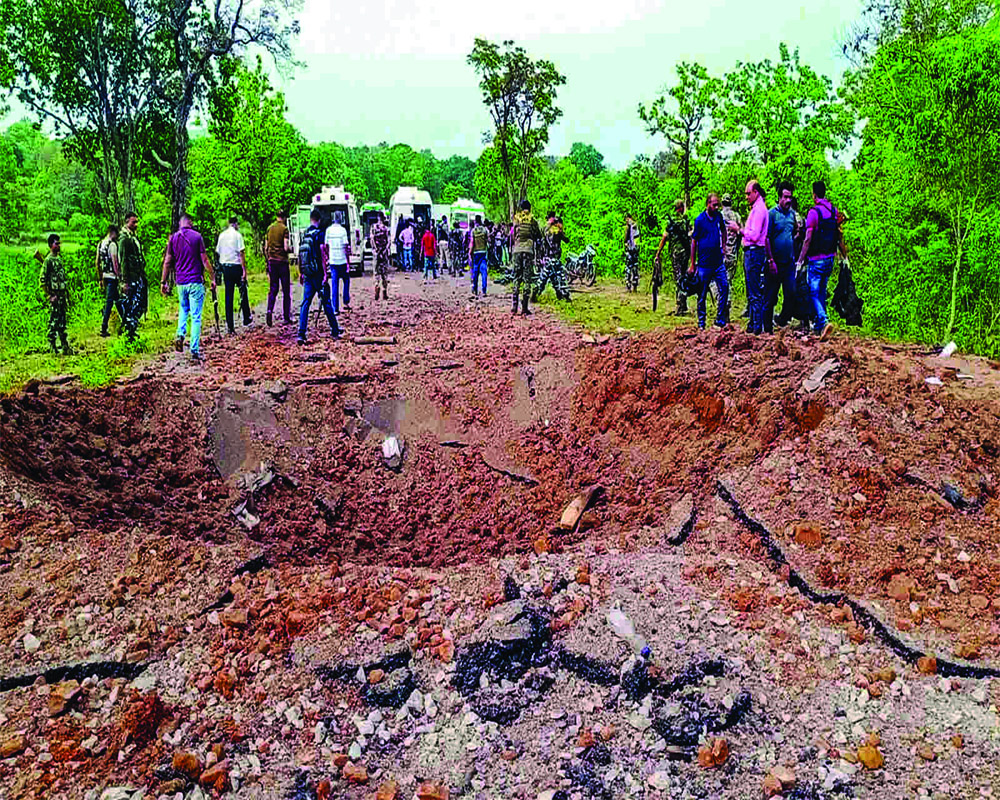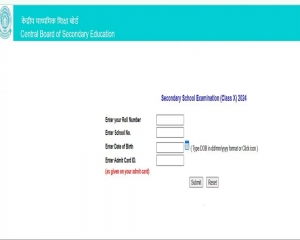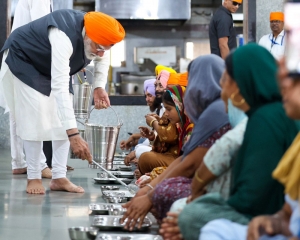Recent threat of terrorists and Naxals have posed new challenges about the changing nature of problems and the quagmire that still lurks
The recent merciless attack by the Naxals killing 10 security personnel of the District Reserve Guards in the Dantewada district of Bastar in Chhattisgarh should roundly be condemned. The naxals have resurfaced with gusto after a period of brief lull. A few years ago 22 Security Personnel were massacred by Naxals in the Sukma-Bijapur border in Chhattisgarh raising serious issues of security and safety of the region. There appears to be a long saga of such attacks of guerrilla attacks by Naxalites. Not long ago in one such attack, 8 CRPF personnel were killed in a landmine ambush at Sukma in Chhattisgarh.
In Consecutive attacks a couple of years ago 300 Naxals attacked the 74th battalion of the largest paramilitary of the country. In 2014 more than 26 Para military security officials and in 2010 more than 70 CRPF personnel were killed in the same area by the Naxals.These killings have once again confirmed that Naxals were down for a while but certainly not wiped out. Chhattisgarh appears to have become the epicenter of such attacks recently. The coming days are going to provide defining moments for state government. Haunted by the Naxalite onslaught on CRPF personnel, the Government is concerned above all about how to nib in the bud these evil genius, which are leading the entire security apparatus down the road of disaster. The manner of naxal recent attacks with the help of improvised devices and modus operandi reveals unprecedented ruthlessness. The current state of affairs does not offer any hope of reconciliation and negotiation from Naxalites.
Gunning down of coal mine officials, blowing up rail lines, torching trucks, beheading police officials, attacking police pickets, and rampant murdering of innocent civilians used to be dramatic scenes in movies of the ’70s that are haunting post-modern India. The repeated ruthless attacks despite the recent warning of the Prime Minister show the level of audacity among the present breed of Naxalites. The present naxal attack has reminded us of the the cold-blooded murder of Inspector Francis Induwar by the Maoist Guerrillas a few years ago which sent the message loud and clear that it is difficult to persuade the Naxals to change their mind by reason, honour or by threat.
During the last few years or so, the simmering rural unrest has continued to find its outlet in the form of violence in states like Chhattisgarh, West Bengal Andhra Pradesh, Bihar and Orissa. The recent incidents of naxal violence suggest that most of the targets are selected in the hope that the people would change their opinion about the potency of the government’s authority. The Naxalites also plan their attack in such a way that people see in them the justification and fulfilment of a cause leading to a just order according to their perception of justice. This, they hope, will ultimately lead to overthrowing of a particular order. Thus, they are attempting to inspire and manipulate fear to achieve a variety of purposes.
Attacks on important government buildings, telephone exchanges, railway stations, villages and police pickets have become quite common. In some areas where there was a lull for a long, a recurrence of Naxalite activity has disturbed the peaceful ambience.
Earlier Bihar witnessed a phase of naxal activities as various extremist organisations were operating, including the Indian People’s Front, the MKSS ( Mazdoor Kisan Sangram Samiti ) and the Maoist Communist Centre. There have been several attacks on police pickets by them. In some areas of Central Bihar, their underground operations are on the rise. The naxals raise funds using extortion from contractors, securing small contacts, and subscriptions from corrupt officials and powerful landlords. Although it is difficult to know the actual strength of these groups, the Maoist Communist Centre is considered to be the most organised with sophisticated weapons. A few years ago, the massacre of 11 people near Dodadih Hills in Bihar by the MCC almost turned basic issues into caste- war-like situations. There have been numerous instances of such gruesome acts by the MCC. The group is very active in Central Bihar districts such as Patna, Jehanabad, Gaya, Nalanda and Navada. In Jehanabad areas, the mobilisation of weaker sections by the IPF and the MKSS has been mainly based on a common concern for equitable distribution of land and payment of minimum wages, among other things. The MCC has been responsible for the Darmiam, Dalelchak Baghora, Bakridh and Bara incidents. After the Dalelchak Baghora ( Aurangabad ) massacre, the state government declared a ban on the activities of the MCC.
Over the years, the government of Andhra Pradesh has suffered a heavy loss of public and private property because of the upsurge in Naxalite activities. In the last two decades, the People’s War Group has made several attempts to emphasise its rights. Dissatisfied with government policies, it has lashed out violently and continues its activities which include bank robberies, murder of policemen, kidnapping of businessmen and officials and political assassination attempts.
Despite the repeated attempts of state and central government to control the menace the problem of naxalism is still growing. They are a misled lot who have been manipulated for political gain by some powerful syndicates. The general masses have been caught in a dilemma of the highest order in such affected areas neither they can go against the bands of distraught people nor can they be a supporter of security forces. They would have to face the wrath and dagger of one group or another if sides are taken. There is a strong need for political will to break down the the psychological state of fear created by the Naxals and create confidence among them that the state is there by their side.
The formation of COBRA specially designed to fight naxalism is a proactive step by the government of India. But this alone can not yield prompt results unless we bring about coordination between intelligence and local police. Therefore, it is high time we modified our information-gathering exercise and involve a multidimensional mechanism including the support of the media to dilute the sympathetic attitude of people towards the Naxals. The meek nature of people at large has frustrated efforts by security forces to identify a Naxalite immediately. In this regard, there is an urgent need to re-establish faith among the masses in the capability of the Government to protect them. For a permanent solution, it is not sufficient to think about some policy changes in the attitude of the government towards the rural poor: the entire society should make substantial efforts at removing the disadvantages of the poor and maintaining social equilibrium. Police accountability in a democratic society has been debated many times. Recent developments particularly the threat of terrorists and naxals have posed new challenges about the changing nature of problems and quagmire that still lurks. The new tentacles of globalization have created a new basis for the relationship between global, national, local and identity and politics in democratic societies. Certain groups are always ready to use these social cleavages to their advantage by creating a fake image of identity building. This notion has made naxalism also a sort of business venture. People are misled and have been driven into the game of power nemesis. The recent Naxal attack has displayed how potent a trick of Dodging can be by spreading wrong information. At this juncture, the insidious planning and new tentacles of naxalism can be fought back by generating confidence among local masses and through accurate human intelligence and a layer of counterintelligence. Intelligence sharing and contiguity between various branches of police appear to be the only solution to tackle the problem head-on.
(Author, a recipient of the Bharat Gaurav Award, is a Professor and an expert on Strategic Affairs)


























